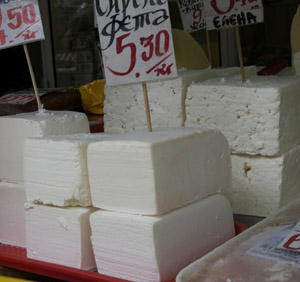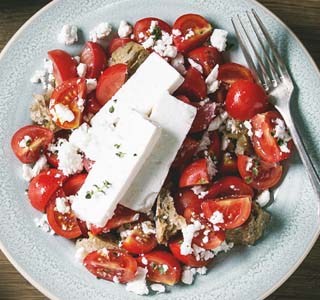Feta cheese
Feta cheese is a very simple, pickled cheese with a clean, acidic, and salty taste. Feta has an ancient pedigree, being first made by nomadic tribes in Greece needing to preserve the milk of their flocks of sheep and goats.
 |
| Bulgarian fet cheese Courtesy: Alex Lovell-Troy |
Feta can be made with cow's, goat's, or sheep's milk or with any combination of the three. This creamy white cheese is made in various shapes and sizes and has a smooth, crumbly texture and no rind. It is stored in a brine solution to prevent drying out and to preserve.
Feta cheese production:
Pasteurization: The milk is heated to 72°C, followed by rapid cooling.
Then, add the bacterial (mesophilic) culture to the milk in the vat at 29°C to curdle (acidify) the milk.
Then, add liquid rennet to the milk. This coagulates milk protein (casein protein in the milk) and separates it from the liquid whey. Cover the pot and let the curd mixture sit undisturbed overnight.
Cutting the curd for feta: The curd is divided into smaller parts, resulting in a larger surface area to aid in easing the whey separation by increasing the surface areas. Gently stir the whey and curd cubes to prevent lump formation.
Molding of feta: Once the whey has drained, the curd particles are transferred into molds, compressed lightly, and left for 1 hour to fuse and take on the shape of the mold. The molded curd is stored at 16 - 18° C.
Seasoning of feta with herbs to be added is done before molding.
Salting of feta cheese: Once the curd has acquired the shape of the mold, the surface of the curd is lightly salted and turned upside down, salted again on the other side, and left for a further 18-20 hours. During this time, the cured cheese particles fuse together while absorbing some of the salt.
Cutting the feta cheese: The product is divided into smaller parts, resulting in a larger surface area to aid further processing. The salted cheese is cut into different-sized pieces and placed in barrels in layers. Dry salt (3% in total) is added over a period of 2 - 3 days.
Then, the cured feta is submerged in a 5% brine solution and left for 12 - 18 days.
Usually, loaf-shaped feta is placed in retail containers along with a brine solution, sealed, and stored under refrigerated conditions.
9 amazing Feta cheese Health benefits
Feta is a moderate-calorie, nutritious cheese packed with good amounts of minerals, vitamins, and protein. 100g feta has 265 calories and 21.5g of total fats.
Feta is the top source of dietary magnesium, calcium, and phosphorous in the Mediterranean diet, and together with vitamin D, plays an important role in bone strengthening and growth, particularly in children.
Feta provides high-quality protein that is rich in all essential amino acids needed for robust growth and development and staying fit and healthy. 100g Feta contains 14.2 g or about 25% of the recommended daily intake of protein.
Feta contains a small amount of lactose (0.13 g/125 g of serving) making it one of the low-lactose dietary sources of protein & calcium in persons with lactose intolerance. Most of the lactose in the milk is converted into more easily digestible lactic acid by the mesophilic bacteria during cheese production.
Feta, being a dairy product, is free of gluten. In gluten-sensitive (Celiac disease) persons, it is another important source of gluten-free food items rich in protein, minerals, and vitamins.
During the ripening process, all the major milk constituents such as lactose, milk lipids, and milk proteins undergo biochemical changes into more easily digestible and health-benefiting products.
The volatile flavoring chemical compounds that originate while aging of feta include acetaldehyde, acetone, ethyl acetate, butane-2-ol, pentane-1-ol, 3-methyl butanal, 3-hydro butanal, hexanal, heptanal, 3-methyl butane-1-ol, etc., give characteristic mildly rancid, slightly acidic and salty taste to it.
Feta is very good source of fat-soluble vitamins, especially vitamin A. 100g of aged feta contains 422 IU (14% of RDI) of this vitamin.
Feta is a very concentrated source of minerals, especially calcium (493 mg or 49.3% of RDI), phosphorus (337 mg or 48% of RDI), zinc (2.88 mg or 26% of RDI) and magnesium (19 mg or 5% of RDI).
| Principle | Nutrient Value | Percent of RDA |
|---|---|---|
| Energy | 265 Kcal | 13% |
| Carbohydrates | 3.88 g | 3% |
| Protein | 14.2 g | 25% |
| Total Fat | 21.5 g | 107.5% |
| Dietary Fiber | 0 g | 0% |
| Cholesterol | 89 mg | 29% |
| Vitamins | ||
| Folates | 32 μg | 8% |
| Niacin | 0.991 mg | 6% |
| Pyridoxine | 0.424 mg | 32.6% |
| Riboflavin | 0.844 mg | 65% |
| Thiamin | 0.154 mg | 13% |
| Vitamin-A | 422 IU | 14% |
| Vitamin-C | 0 mg | 0% |
| Vitamin-D | 16 IU | 5% |
| Vitamin-E | 0.18 mg | 1% |
| Vitamin K | 1.8 μg | 1.5% |
| Electrolytes | ||
| Sodium | 1140 mg | 76% |
| Potassium | 62 mg | 1.3% |
| Minerals | ||
| Calcium | 493 mg | 49% |
| Copper | 0.032 mg | 3% |
| Iron | 0.65 mg | 8% |
| Magnesium | 19 mg | 5% |
| Manganese | 0.028 mg | 1% |
| Phosphorus | 337 mg | 48% |
| Zinc | 2.88 mg | 26% |
Buying
Feta is a white, soft cheese matured in brine. It has a salty and tangy taste, enhanced by maturing it in the brine.
Classical Greek feta is prepared from 70% sheep's and 30% goat's milk. The European Union recognizes traditional Greek feta as a product of Protected Designation of Origin (PDO).
While buying, look for a production date, packing date, and use by date.
According to EU Commission, feta's moisture content should not exceed 56%, and its fat in dry matter content must be at least 43%. It is a white cheese with irregular holes throughout.
Storing
If you have any left-over feta that you bought in an air-seal pack from a grocery, preserve it in homemade brine and place it in the refrigerator for use in the next 2-4 weeks.
Opened and crumbled feta, however, should be kept in the fridge for use in the next 5-7 days.
Food uses
Feta is a versatile, white, soft to semi-firm Greek cheese, which can be included on a cheese platter, topped on bread, salads, pizza, or pie. Greeks exclusively use feta in their recipes.
Feta often contains added herbs and seasonings. It tastes delicious with olive oil, roasted red peppers, and grilled vegetables.
 |
| Cretan salad. Courtesy: Kelios, The Greek Dairy |
Prepare Cretan salad with dakos (bread).
Greek Salad Horiatiki- A light, healthy and tasteful meal, very easy to prepare. Serve it with white bread, such as a baguette.
Use fresh crumbled feta on a traditional Greek salad seasoned with dried oregano, and olive oil.
Spanakopita (spanakotiropita) is a Greek savory spinach pastry.
Safety profile
Feta cheese composes of high sodium levels, which may cause water retention and elevated blood pressure. People with an history of high blood pressure may be advised to restrict eating too much feta in their diet.
Feta cheese contains considerably high amounts of tyramine, and if a person on Mono-amine oxidase inhibitors (MAOI's) medication like Phenelzine (Nardil) consumes cheeses, he may develop a medical emergency known as "hypertensive (high blood pressure) crisis" which have symptoms like severe headache, sweating, nosebleeds, fast heartbeat, chest pain, blurring of vision, shortness of breath, and confusion, and should seek immediate medical attention. Also, they need to continue following a low-tyramine diet for a few weeks after stopping these medications. (Medical Disclaimer)
Source: Mayo clinic: MAOI's and diet.
≻≻-You may also like to read
≺≺Halloumi cheese nutrition facts.
≺≺Ricotta cheese nutrition facts.
≺≺Cheddar cheese nutrition facts.
≺≺Brie cheese nutrition facts.
≺≺-Back to Dairy products from Feta cheese nutrition facts.
≺≺-Back to Home page.
Further Resources:
USDA National Nutrient Database. (opens in new window).
Feta Cheese: - Eskom -Agricultural processing Brochure (opens in new window).
MAOI's and diet. (opens in new window).